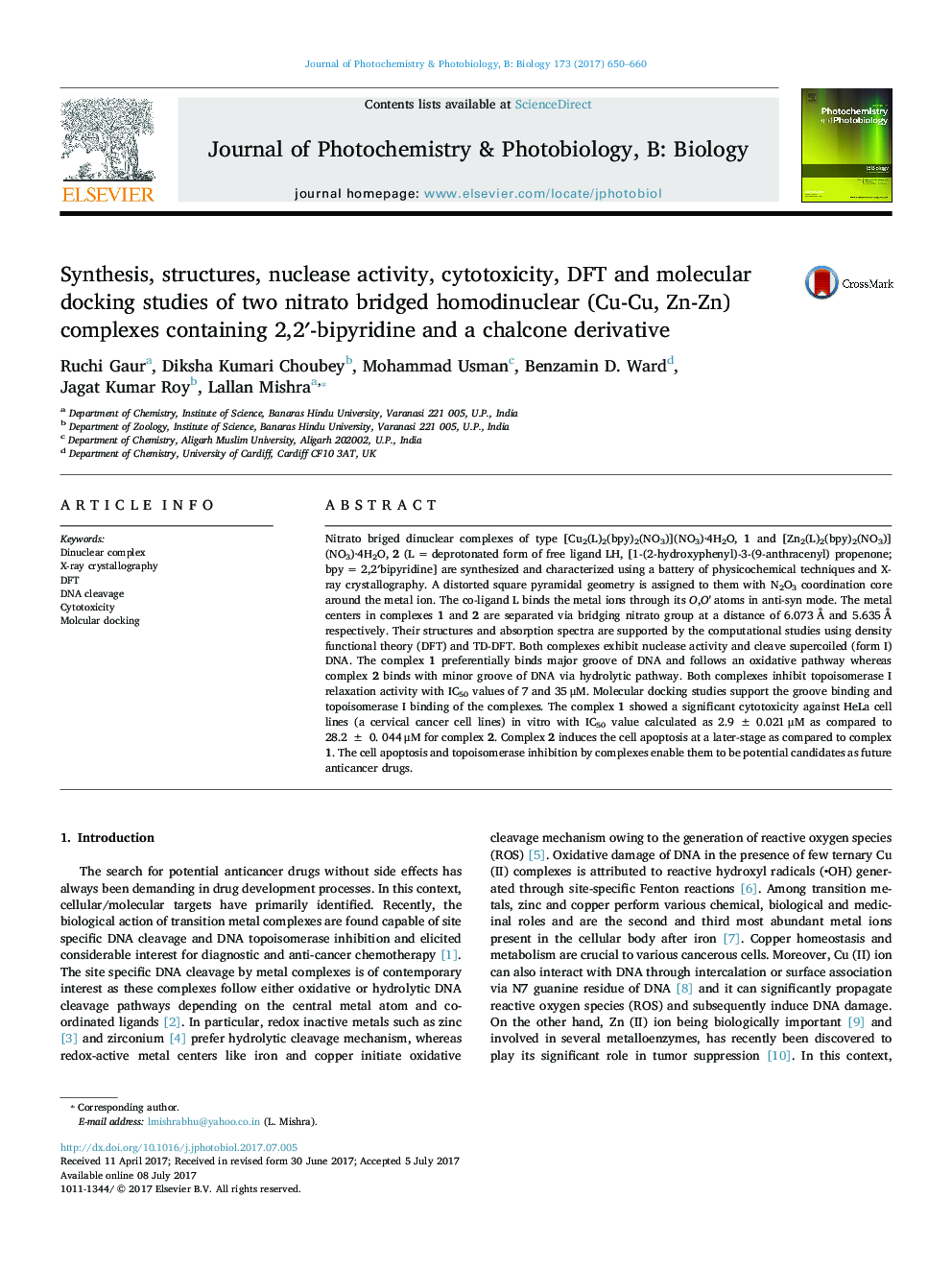| Article ID | Journal | Published Year | Pages | File Type |
|---|---|---|---|---|
| 4754429 | Journal of Photochemistry and Photobiology B: Biology | 2017 | 11 Pages |
â¢Nitatobridged dinuclear Cu(II) and Zn(II) complexes are prepared and characterized.â¢Complexes contain 2,2â²-bipyridine and an anthracenyl chalcone as ligands.â¢Both complexes are active against Hela Cell lines.â¢DNA binding of the complexes are supported by molecular docking studies.â¢They inhibit topoisomerase I with IC50 values of 7 and 35 μM respectively.
Nitrato briged dinuclear complexes of type [Cu2(L)2(bpy)2(NO3)](NO3)·4H2O, 1 and [Zn2(L)2(bpy)2(NO3)](NO3)·4H2O, 2 (L = deprotonated form of free ligand LH, [1-(2-hydroxyphenyl)-3-(9-anthracenyl) propenone; bpy = 2,2â²bipyridine] are synthesized and characterized using a battery of physicochemical techniques and X-ray crystallography. A distorted square pyramidal geometry is assigned to them with N2O3 coordination core around the metal ion. The co-ligand L binds the metal ions through its O,O' atoms in anti-syn mode. The metal centers in complexes 1 and 2 are separated via bridging nitrato group at a distance of 6.073 à and 5.635 à respectively. Their structures and absorption spectra are supported by the computational studies using density functional theory (DFT) and TD-DFT. Both complexes exhibit nuclease activity and cleave supercoiled (form I) DNA. The complex 1 preferentially binds major groove of DNA and follows an oxidative pathway whereas complex 2 binds with minor groove of DNA via hydrolytic pathway. Both complexes inhibit topoisomerase I relaxation activity with IC50 values of 7 and 35 μM. Molecular docking studies support the groove binding and topoisomerase I binding of the complexes. The complex 1 showed a significant cytotoxicity against HeLa cell lines (a cervical cancer cell lines) in vitro with IC50 value calculated as 2.9 ± 0.021 μM as compared to 28.2 ± 0. 044 μΠfor complex 2. Complex 2 induces the cell apoptosis at a later-stage as compared to complex 1. The cell apoptosis and topoisomerase inhibition by complexes enable them to be potential candidates as future anticancer drugs.
Graphical AbstractThis is the first report of nitrato bridged dinuclear complexes against their anticancer activity. Nitrato bridged homodinuclear metal [Cu(II)-Cu(II), Zn(II)-Zn(II)] complexes containing 2,2â²-bipyridine together with chalcone embedded with anthracene in their skeleton showed self-cleavage of DNA via oxidative and hydrolytic pathway respectively. They also inhibited Topo I activity together with significant cytotoxicity against HeLa cell lines. The complex 2 also induces the cell apoptosis but at a later-stage as compared to complex 1.Download high-res image (172KB)Download full-size image
